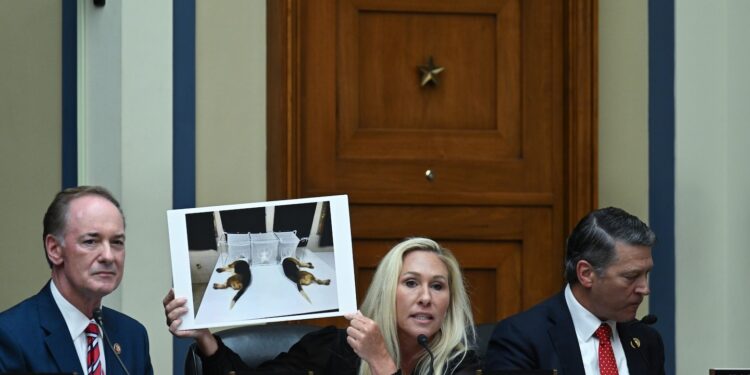— Rep. Marjorie Taylor Greene (R-Ga.), questioning Anthony S. Fauci, the former director of the National Institute of Allergy and Infectious Diseases (NIAID), during a House hearing on the origins of the coronavirus pandemic, June 3
“What does dogs have to do with anything that we’re talking about today?”
During the coronavirus hearing this week, Greene attacked Fauci as she held up a photo of two sedated puppies, their heads placed in mesh cages, as they lie on a table while being swarmed by sand flies. Outside the hearing, an ad truck commissioned by a group opposed to taxpayer-funded animal experiments circled Capitol Hill with billboards that showed Fauci together with this photo and directed people to a website called BeagleGate.org. The group, the White Coat Waste Project, is founded and run by people with links to conservative-leaning organizations, The Washington Post has reported.
When we first saw Greene hold up the photo, we figured this would be easy to debunk — another in a string of misleading attacks against Fauci, who became the public face of the government’s response to the pandemic.
After all, when this first became an issue in 2021 — unrelated to covid then as it is now but part of a general effort among conservatives to discredit Fauci in any way possible — a raft of fact checks noted that the National Institutes of Health (NIH) said the study in question, conducted in Tunisia, had been attributed in error to the agency that Fauci ran, a division of NIH. The scientific journal that published the study issued a correction. NIH said that it did fund a study in Tunisia involving dogs and sand flies, but NIH suggested that study was a more benign one that allowed the dogs to roam.
But it’s more complicated than that, a review of NIH emails and documents obtained by the group since 2021 under the Freedom of Information Act suggests. Some of the documents call into question NIH’s statements at the time, part of what appears to be a bungled public relations response.
What’s less complicated is that it’s silly to personally blame Fauci for the design of research studies — about 5,500 were approved by NIAID just in 2023 — endorsed many levels below the director. “The experiments that NIH funded go through strict regulatory processes of the treatment of animals, the humane treatment of animals,” Fauci said in response to another lawmaker who raised the issue in the hearing this week. “I signed off on them because they were approved by a peer review.”
Female sand flies carry a parasite that produces zoonotic visceral leishmaniasis (ZVL), an often-neglected tropical disease in humans. Domestic dogs are the main reservoir host and sand flies are the main vector. The problem is especially acute in Tunisia, where a 1996 study of 50 cases in one hospital found a mortality rate of about 6 percent in children under the age of 5.
Animals are often used in research, where they serve as “models” that allow for investigation of a problem. NIH, on its website, notes that fish, frogs, fruit flies and roundworms are used to understand biological processes that could affect humans.
But there is something about using dogs — especially common household pets such as beagles — that make many people squeamish. According to the most recent annual animal usage report by the U.S. Agriculture Department, nearly 16,000 dogs in 2019 were subjected to pain in the United States during research experiments — and nearly 400 received no pain medication.
The White Coat Waste Project hit a nerve when it publicized the Tunisia sand fly study in 2021, emphasizing the dramatic photo that Greene waved at Fauci. The Post reported that Fauci’s office got 3,600 phone calls in 36 hours. A bipartisan letter signed by 24 members of Congress, citing the group’s reports on animal studies, said that lawmakers had “grave concerns about reports of costly, cruel, and unnecessary taxpayer-funded experiments on dogs.”
The Tunisian sand fly study pictured in the photo was published on July 27, 2021, in the journal PLOS Neglected Tropical Diseases. The study described how the beagles, between 6 and 8 months old, and obtained from the kennels of the Pasteur Institute of Tunis, were sedated and then exposed to hundreds of sand flies that had been deprived of food for 24 hours.
That August, the study caught the attention of White Coat Waste, where the story was quickly picked up by right-leaning websites.
Fauci seeks information about the dog study grant
In late October 2021, CNN asked Fauci to appear for an interview, and one of his staff members suggested late on Oct. 24 that Fauci pause any TV interviews “until we get a handle on this.” Early the next morning, Fauci emailed 12 officials and asked them to “tell me what grant or contract they are referring to.” Within two hours, one replied that they might have identified the grant. (Most staff members’ names are redacted.)
“Let us find out for sure if it is that grant, and then let us take a look at what the experimental design is, and importantly whether it has received the appropriate ethical and animal care consideration,” Fauci replied in an email. “I want this done right away since we are getting bombarded by protests.”
Within two hours, one of the researchers involved, Abhay Satoskar, a professor of pathology and microbiology at Ohio State University, emailed to say that NIAID had been mistakenly cited as a funder of the study and that he would seek a correction from the journal. One NIAID official wrote in an email that Satoskar “stated that it was mistakenly cited because he was not clear of the true purpose of US funding acknowledgment” and that the program in question had been funded only by the Pasteur Institute.
NIAID issued a public statement on Oct. 26 saying it had funded a separate sand flies project involving the study of a vaccine to prevent leishmaniasis. In this study, 12 dogs were given the vaccine and then put in “an enclosed open space” outside during high sand fly season, NIAID said, to see whether the dogs still became infected.
Relying on a single researcher’s statement
The emails obtained by White Coat Waste show that NIAID officials were relying on Satoskar’s statement and had no independent knowledge of whether it was correct. When an Associated Press reporter doing a fact check asked for proof that NIAID did not fund the project, one NIH official on Oct. 28 internally admitted it had none.
“Our evidence is simply the statement of the PI, Dr. Satoskar,” the official wrote to another NIAID official, using an abbreviation for principal investigator, according to the emails. The official added: “It is not uncommon for investigators to give very wide attribution to grants and contracts that supported a given project, so it is not surprising that they went too broad in acknowledging support of the publication.”
Matthew Fenton, director of NIAID’s Division of Extramural Activities, replied as part of the email chain: “It seems to me that the only way to prove that the grant funds weren’t used for other projects is to do an audit of those grant expenditures and invoices. This would not be something that could be done quickly.”
NIH declined to answer whether an audit was ever undertaken and whether NIAID confirmed what Satoskar said.
A potential conflict of interest, and a correction
Meanwhile, the emails show that when Satoskar asked Shaden Kamhawi, the editor of the journal, to correct the article, she agreed immediately but noted internally that she might have a conflict of interest because she was an employee of NIAID. (Her bio on the NIAID website also listed Satoskar as one of her “main collaborators.”)
“As I am an NIAID employee, I am not sure if there is a COi here so please let me know,” she wrote in an email to colleagues that was written just six hours after Fauci first asked for information.
NIH also declined to answer questions about her potential conflict, but the emails obtained by White Coat Waste contain a draft statement to be given to reporters if the question arose. “The request for a correction of the funding statement came from the authors of the study,” the statement said. “It is a standard policy of the journal of PLOS Neglected Tropical Diseases and its responsibility as a publisher to correct publication errors when made aware of them. None of Dr. Kamhawi’s supervisors at NIAID were involved with the journal’s decision to make this correction.”
The press guidance said Kamhawi became aware of the issue only in November, though the internal emails show she learned of it on Oct. 25, the same day Fauci asked about it.
Study is removed from the NIH database
When The Post reported on the controversy in November 2021, the article noted: “The trapped-beagles study does not appear in a database of NIH-funded projects.” The emails show that, while it was removed before the publication of The Post article, the study had been listed in the database for months and was still listed as of the previous month, when Fauci first asked about the controversy.
“We need that to be corrected too, ASAP please,” one NIH staffer wrote on Oct. 27. The anxiety level rose as officials realized it would take several days, until Nov. 1, before the project would be removed from the database — where reporters could not then find it.
NIH also declined to answer questions about the removal of the study from the database.
A second study also caged dogs
Finally, other documents obtained by White Coat Waste suggest the Tunisia study funded by NIH was not as benign as the agency suggested. Instead of an “enclosed open space,” the study’s grant application shows a photograph that indicated that the dogs were kept in a cage as they were “exposed to sand fly bites each night through the sand fly season to ensure transmission.” The grant application also described how, separately, dogs would be sedated and placed in cages for two hours while they were exposed to 15 to 30 female sand flies.
In a statement, NIH said: “The two studies began at different times and involved different animals. The study in the journal PLOS Neglected Tropical Diseases used symptomatic animals from previous studies approved by that grantee institution’s animal care and use committee in 2012. NIAID funds were used for an R21 study [Exploratory/Developmental Grant] that started in August 2018 and ended in July 2021. Information from the principal investigator shows 12 healthy dogs were vaccinated and sent into the field in 2019 for natural exposure during Sand fly season (August to November) to test a candidate visceral leishmaniasis (VL) vaccine. According to the study’s principal investigator, the 12 dogs were healthy and did not have symptoms of VL at the conclusion of the NIAID-funded grant period.”
Satoskar referred questions to Benjamin Johnson, an Ohio State University spokesman. “We have nothing more to add,” Johnson said.
The emails show that NIH was not fully transparent as it tried to handle a public-relations nightmare. Perhaps there was little reason to doubt Satoskar, but officials embraced his explanation without confirming as they rushed out a statement. They made no acknowledgment that they had removed the study from the NIH grant database or that the editor of the journal that quickly issued the correction had a potential conflict of interest. Moreover, the NIH study in Tunisia that the agency said it funded was cast in a positive light that is undermined by the grant application that has since been made public.
Send us facts to check by filling out this form
Sign up for The Fact Checker weekly newsletter
The Fact Checker is a verified signatory to the International Fact-Checking Network code of principles






